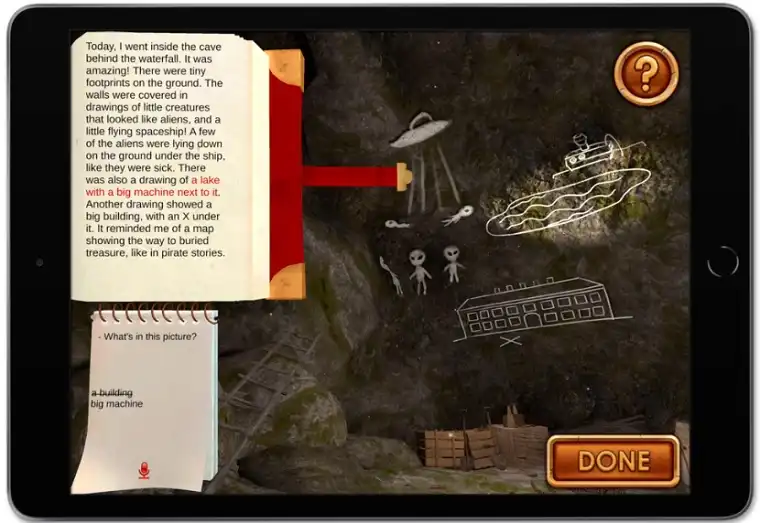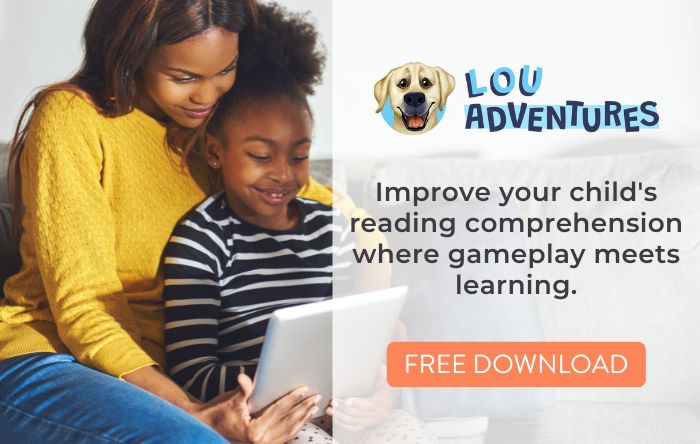Are you looking for reading comprehension strategies to help your child or student better understand what they are reading?
Learning to read is one of the biggest milestones your child will achieve in elementary school.
After all, reading is essential to learning. It’s the foundation for every other subject, from history to science.
Once your child knows how to read, they’ll be able to unlock a whole world of exciting new information.
Simply being able to sound out letters or recognize words on the page, however, isn’t all there is to meaningful reading.
The most important component of being a strong reader is comprehension. This means actually absorbing information from the words on the page, and synthesizing it with your own understanding.
When your child comprehends what they’re reading, they appreciate the meaning of the text itself.
Reading comprehension helps your child understand new concepts, learn new vocabulary, and enhance their understanding of the world around them.
Reading comprehension boosts memory, attention span, and critical thinking skills. It also improves your child’s reading experience, since they’re able to understand and enjoy the story.
Even though we all understand the importance of reading comprehension, this piece of the puzzle can be tricky for some young readers to put into place, however.
If you’d like to boost your child’s reading comprehension, read on to learn five strategies designed to help your child hit their reading goals.
Disclosure: Some of the links in this article are affiliate links, meaning at no additional cost for you, we might get a commission if you click the link and purchase.
5 Highly Effective Reading Comprehension Strategies
1. Spark Their Interest
One of the simplest ways to enhance your child’s reading comprehension is to make sure they’re interested in the text itself.
Lack of concentration often stems from feeling disinterested or disconnected from the reading material your child is given.
At school, kids may not always be able to pick books or reading passages that appeal to their interests, but this doesn’t have to be the case at home!
Let your child read about something they find fascinating, whether it’s outer space, animals, cartoons, or sports.
Local libraries have thousands of books (and eBooks, in many cases), so you don’t have to break the bank to explore your child’s interests.
When kids read about something that appeals to them personally, there’s already a higher level of “buy-in,” or personal investment, in the story.
If your daughter is reading about her favorite animal, she’s going to pay better attention because she’s intrinsically motivated. This means she’s focusing on the story for her own sake, not to please you or check off a homework assignment.
Any time you can tap into your child’s intrinsic motivation, you strengthen the idea that reading is a fun way to learn more about the things we love.
2. Keep it Level
Another key element to reading comprehension is making sure your child is reading books on their reading level.
If they’re attempting to tackle a story that’s way too difficult, your child might be tempted to slam the book closed in a fit of frustration.
After all, even adults can relate to the feeling of wading through confusing forms full of tricky jargon… definitely not a fun reading experience.
Meanwhile, books that are too easy for your young reader might have him or her zoning out and thinking about what’s for lunch instead of what’s happening in the story.
To ensure that your child is reading on their level, you can talk to their teacher for book recommendations.
You can also follow the “Five Finger” rule to get a general idea of whether a book is a good fit.
To do this, have your child skim the first page of a book they’re considering. Every time they get to a word they don’t know, your child should put up one of their fingers.
Ideally, they should have two or three fingers up by the end of the page. This means the book is challenging without being too hard to understand.
Of course, if a book ends up being too tricky, it doesn’t have to come off the table entirely.
Instead, make a point to read that one with your child, so you can keep them from feeling overwhelmed.
3. Mix It Up
Not all meaningful reading needs to involve a physical book. Instead, let your child mix things up by reading on one of the many entertaining digital platforms available.
An ideal reading program for young readers (grades 2-4) is Lou Adventures, a free interactive game in which students read aloud and answer questions as they work to solve a mystery.
Guided by Lou, a friendly talking dog, kids go on a quest for clues by reading chunks of text out loud and then answering the questions that follow each passage.
The reading app uses voice recognition technology and records your child’s reading, so you can listen to where they’re succeeding and where they might need more help.
Kids can opt for Lou to read the passages out loud instead if they’re finding the text too challenging. Lou will also prompt kids to go back and reread key sections if they’re struggling on the questions.
Lou Adventures lets kids unlock games as they play, which incorporate important comprehension strategies like using context clues and identifying synonyms.
The app even includes a built-in Parent Dashboard, so you can monitor their progress without hovering over your child’s shoulder.
Lou Adventures is entertaining enough to hold young readers’ interest while seamlessly encouraging good reading comprehension practices.
Since it’s free of charge, Lou Adventures is an excellent option for parents trying to add a little variety to their child’s reading routine.
You can read our Lou Adventures review for our full thoughts on the app or click here to try Lou Adventures for free.
 Lou Adventures: An Interactive Learning Story for Kids
Lou Adventures: An Interactive Learning Story for Kids
Lou Adventures is an interactive learning story for kids that helps them improve their reading skills through a fun, adventurous game.
4. Start a Conversation
Another painless way to increase reading comprehension is by encouraging your child to talk about what they’ve read.
Whether they’re using an app, reading a novel, or browsing a comic book, make time to ask them about what’s going on in the story.
Letting your child retell the main idea of a text is one of the best ways to check for real understanding. You can always prompt them with a few questions if it seems like they’re not getting the big picture.
A simple way to make sure your child’s summary is covering the bases is by using the “SWBST” format. This stands for “Somebody… wanted… but… so… then…”
Having your child finish these sentence starters will usually ensure that they understood the major plot points of whatever story they’re reading.
It’s also a great idea to discuss whatever book you’re reading, too. You don’t have to give your child every detail, but filling them in on the gist shows that discussing books is something adults do too.
Your conversation doesn’t have to revolve solely around retelling the story, either. Ask for your child’s opinion, favorite character, or least favorite part.
Talking about reading makes the story become more real for your child, which makes comprehension come more naturally.
5. Repeat After Me
Don’t be afraid to read a story more than once! Repetition is a great way to increase comprehension, especially for hesitant readers.
Rereading can build your child’s confidence, since they’ve already seen the words on the page.
Taking a second look at a book also makes it easier for your child to understand the plot, since they’ve had more time to think about it and identify the characters, problem, and solution.
For younger readers, it’s a good idea to do a “pre-read” or “picture walk,” in which they flip through the book to check out any headings or pictures in the story.
Ask your child to make predictions on the “pre-read” and see if they come true after they read the story closely.
A “post-read” can work just as well. Let your child turn back to their favorite part, or have them find the part of the story that showed the problem or the solution.
Getting in the habit of returning to the text will set your child up for stronger reading comprehension in all subject areas later down the road.
Rereading will also help your child build fluency, since they will be able to read faster and more accurately each time they repeat a text.
A higher level of fluency often corresponds to better comprehension, since your child is free to think deeply about the story instead of struggling over each individual word.
Final Thoughts on Reading Comprehension Strategies
Strong comprehension is the secret sauce when it comes to helping your child enjoy reading.
After all, no one wants to do an activity that leaves them confused or bored. When kids don’t comprehend what they’re reading, however, this is exactly what they’re going to feel.
You can keep this from happening by incorporating all of the strategies above.
Keep the subject matter appealing to your child.
Make sure their books are hitting the sweet spot of being challenging, but not impossible.
Swap out books for entertaining and educational apps like Lou Adventures from time to time.
Talk about what you’re reading together and let your child summarize what’s going on in the story.
Lastly, don’t hesitate to reread a passage or book a few times to really let your child get the most out of it.
These simple strategies will help your child begin to really understand and enjoy what they’re reading.
Once they’ve gotten that piece in place, there’s no limit to what your reader will learn and discover.
Do you know any other great reading comprehension strategies to improve a young reader’s understanding? We’d love to hear any additional tips and ideas in the comments below!


